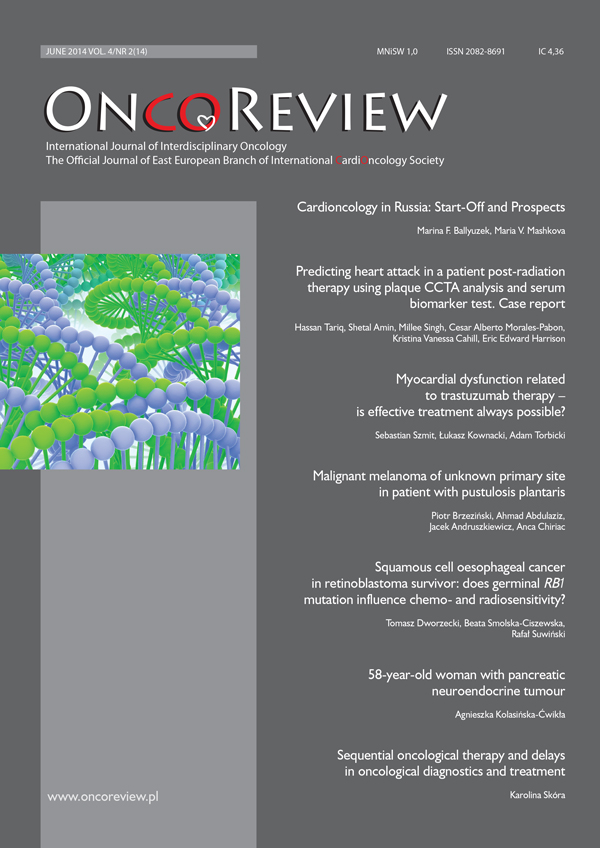Predicting heart attack in a patient post- -radiation therapy using plaque CCT A analysis and serum biomarker test. Case report Case report
Main Article Content
Abstract
Accelerated coronary artery disease (CAD) is a long term manifestation of chest irradiation that may progress to acute myocardial infarction (MI). We report the use of an algorithm-based biomarker test and coronary computed tomography angiography (CCTA) to identify accelerated CAD in a patient treated with chest irradiation and combination chemotherapy for non-Hodgkin?s lymphoma (NHL). Using a seven protein biomarker test with four incorporated clinical factors, we identified the patient had a 6 fold higher risk for future MI than expected for individuals at his age. Using CCTA, we characterized his plaques based on the following parameters: percent diameter stenosis (ranging from 30?70), percent area stenosis, percent necrotic core (NC), percent fibrotic core (FC), percent calcium core (CC), FC thickness, percent vessel wall to lumen, and NC to FC ratio. We identified a plaque in his left circumflex (LCX) with moderate percent diameter stenosis, high percent NC, low percent FC, absent FC thickness, high percent vessel wall to lumen ratio, and high NC to FC ratio as the most vulnerable to rupture and cause MI. The patient was educated about his risk of a future MI and started on maximum medical therapy. Nevertheless, he experienced a ST elevation MI (STEMI) in 185 days with occlusion at the vulnerable plaque site of his LCX. The recognition of a vulnerable plaque in a vulnerable patient may necessitate prophylactic stenting in vessels without severe obstruction. The serum biomarker test and CCTA plaque analysis may detect these patients in need of aggressive therapy.
Downloads
Metrics
Article Details

This work is licensed under a Creative Commons Attribution-NonCommercial 4.0 International License.
Copyright: © Medical Education sp. z o.o. This is an Open Access article distributed under the terms of the Attribution-NonCommercial 4.0 International (CC BY-NC 4.0). License (https://creativecommons.org/licenses/by-nc/4.0/), allowing third parties to copy and redistribute the material in any medium or format and to remix, transform, and build upon the material, provided the original work is properly cited and states its license.
Address reprint requests to: Medical Education, Marcin Kuźma (marcin.kuzma@mededu.pl)
References
2. Berardi R, Caramanti M, Savini A et al. State of the art for cardiotoxicity due to chemotherapy and to targeted therapies: a literature review. Crit Rev Oncol Hematol 2013; 88(1): 75-86.
3. Walker J, Bhullar N, Fallah-Rad N et al. Role of three-dimensional echocardiography in breast cancer: comparison with two-dimensional echocardiography, multiple-gated acquisition scans, and cardiac magnetic resonance imaging. J Clin Oncol 2010; 28(21): 3429-36.
4. Cardinale D, Cipolla CM. Assessment of cardiotoxicity with cardiac biomarkers in cancer patients. Herz 2011; 36(4): 325-32.
5. Lenihan DJ. Cardiac biomarkers, cardiotoxicity, and active collaboration: is this the final frontier or the wave we should catch? J Am Coll Cardiol 2014; 63(8): 817-8.
6. Lenihan DJ. Evaluation of cardiotoxicity. In: Best practice model. Harrison E.E. (Ed.) 2014 (in print).
7. Lestuzzi C. Cardioncology, oncocardiology. Are we barking up the wrong tree? Int J Cardiol 2013; 167(2): 307-9.
8. Cross DS, McCarty CA, Hytopoulos E et al. Coronary risk assessment among intermediate risk patients using a clinical and biomarker based algorithm developed and validated in two population cohorts. Curr Med Res Opin 2012; 28(11): 1819-30.
9. McEvoy JW, Diamond GA, Detrano RC et al. Risk and the physics of clinical prediction. Am J Cardiol 2014; 113(8): 1429-35.
10. Stone GW, Maehara A, Lansky AJ et al. A prospective natural-history study of coronary atherosclerosis. N Engl J Med 2011; 364(3): 226-35.
11. Yamamoto H, Awai K, Kuribayashi S et al. Rationale and design of the PREDICT (Plaque Registration and Evaluation Detected In Computed Tomography) registry. J Cardiovasc Comput Tomogr 2014; 8(2): 90-6.

